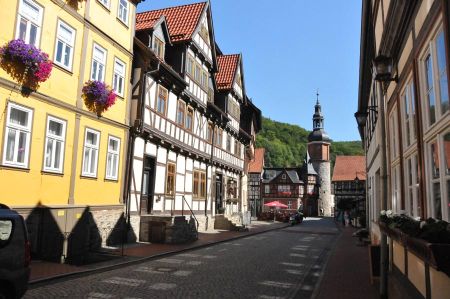Stolberg – One of the pearls of the Southern Harz
- Written by Portal Editor
On the way to our authors' meeting in Halle, we wanted to visit the Harz town of Stolberg again, which we could only pass by during our last excursion in the spring due to lack of time, but which we had still had in mind due to the wonderful half-timbered buildings.
At Seesen we left the BAB 7 in the direction of Osterode and Bad Lauterberg according to our planning. The predominantly 4-lane expressway 243 quickly brought us to Nordhausen to the BAB 38 motorway in the direction of Halle. Just a few kilometres later we left the Autobahn at the Berga exit (already within sight of the Kyffhäuser monument / Kaiser Barbarossa) and now we drove on the L236 towards Rottleberode. It is just 17 kilometres from the motorway exit to the centre of Stolberg. We also found a parking lot in the middle of the village, since only a few tourists stayed in the village.
Stolberg - an El Dorado for friends of medieval half-timbered buildings
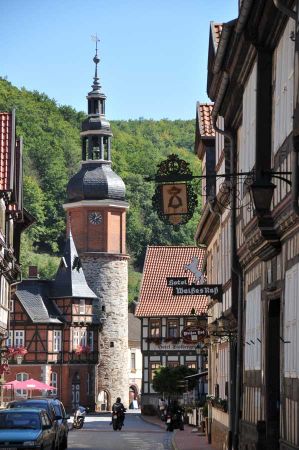 Anyone who is interested in medieval half-timbered buildings, which, due to the relatively narrow valley, just line up along the two main roads, will find a true paradise in Stolberg. Beautifully designed in colour, one half-timbered building is lined up next to the next, gables and doors in such a variety that you will not find in such numbers elsewhere. It was immediately in our mind that it would not be the last visit to Stolberg.
Anyone who is interested in medieval half-timbered buildings, which, due to the relatively narrow valley, just line up along the two main roads, will find a true paradise in Stolberg. Beautifully designed in colour, one half-timbered building is lined up next to the next, gables and doors in such a variety that you will not find in such numbers elsewhere. It was immediately in our mind that it would not be the last visit to Stolberg.
The street design in Stolberg is interesting and probably unique in Germany. At the entrances to the city there is a sign for 30 km / h and no-parking zone (with a parking disc, parking is permitted in marked areas for one hour). Otherwise there are no street signs in town. Although there is a visible separation between sidewalk and street, this can be seen as an early form of shared space approach with the real meaning "shared space". Shared space describes a planning philosophy according to which traffic-dominated public street space is to be improved and safer in traffic flow. The idea of not using traffic signs, signal systems and road markings is characteristic. At the same time, road users should be given full equal rights, whereby the right of way rule continues to apply. In contrast to conventional traffic calming, it should also be possible to use it on main roads.
800 years of the city history of the city of Stolberg
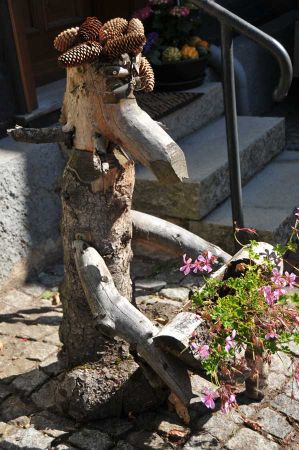 The more than 800 year old history of the half-timbered town of Stolberg can still be seen in the unique historical cityscape today. Also unmistakable is the centuries-old supremacy of the royal family, whose castle dominates high above the city on a rocky outcrop. We deliberately save the visit to the castle for another day in Stolberg, because even in winter it can be fantastic. Due to the surroundings, the layout of the urban area has hardly been able to change over time. Since the Middle Ages, four streets - Niedergasse, Rittergasse, Neustadt and the cold valley - have defined the cityscape, which is characterized by half-timbered houses from the 15th to 19th centuries. As already mentioned, a further expansion was not possible due to the geological conditions. In the period from 1450 to 1550, about 1,350 to 1,700 people lived in Stolberg, in 1724 there were about 2,580 and today there are only 1,300 inhabitants.
The more than 800 year old history of the half-timbered town of Stolberg can still be seen in the unique historical cityscape today. Also unmistakable is the centuries-old supremacy of the royal family, whose castle dominates high above the city on a rocky outcrop. We deliberately save the visit to the castle for another day in Stolberg, because even in winter it can be fantastic. Due to the surroundings, the layout of the urban area has hardly been able to change over time. Since the Middle Ages, four streets - Niedergasse, Rittergasse, Neustadt and the cold valley - have defined the cityscape, which is characterized by half-timbered houses from the 15th to 19th centuries. As already mentioned, a further expansion was not possible due to the geological conditions. In the period from 1450 to 1550, about 1,350 to 1,700 people lived in Stolberg, in 1724 there were about 2,580 and today there are only 1,300 inhabitants.
Small town house - a typical late Gothic artisan house
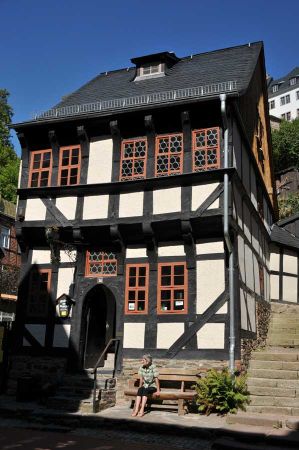 We were particularly fascinated by the "Kleine Bürgerhaus", one of Stolberg's oldest houses in Rittergasse 14. Since the 1930s, this house, built around 1470, has been used as the local history museum. The history association founded in 1924 had acquired it to present its collection of the "Stolberger antiquities". The building, a typical late Gothic artisan house, houses everyday objects and evidence of living culture from the 17th to 19th centuries.
We were particularly fascinated by the "Kleine Bürgerhaus", one of Stolberg's oldest houses in Rittergasse 14. Since the 1930s, this house, built around 1470, has been used as the local history museum. The history association founded in 1924 had acquired it to present its collection of the "Stolberger antiquities". The building, a typical late Gothic artisan house, houses everyday objects and evidence of living culture from the 17th to 19th centuries.
The equipment of the small-town house includes a shoemaker workshop and a kitchen on the ground floor as well as a wooden room, a living-room and a bedroom on the upper floor. It's hard to believe that the whole family has found a place in the kitchen. The Kirchner J.A. John lived here in the house with 6 other people. The authentic representation of the rooms also inspired filmmakers who were already using the house as a film set.
The previously mentioned wooden room, a so-called plank room, is one of the oldest of its kind. In Stolberg, several of these wooden rooms have already been rediscovered during restoration work. Thanks to a special technique, the rooms were completely lined with wood and are mostly on the upper floor. Preserved corner stands can be seen in the Ratskeller and in the Museum Alte Münze, fully restored rooms in the building at Am Markt 12 and in Rittergasse 11. The tiny bedroom initially suggests a child's room. In the past, however, many people slept sitting.
From the archives it is known that from the family of the Johns, among others, the Kirchner Kilian John lived here in this house. In 1627, according to records, Kilian John asked for financial help to repair the house. In 1735 the tin foundry Johann Friedrich Vockenrodt sold it to Just Reidemeister for 285 guilders. Most recently, the house was owned by the shoemaker Worch.
The Count Families - Count Botho zu Stolberg
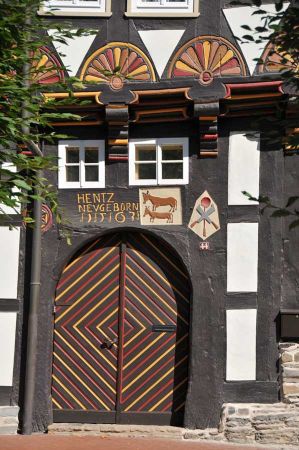 The village of Stolberg probably originated around the year 1000 as a mining settlement, since iron, copper, silver, tin and gold had been mined in the Harz for some time. Mining in the Stolberg area has been recorded in writing at least since 794. The first documentary mention comes from the year 1210 in connection with the count family residing here. Before 1300, Stolberg was granted city rights. From the beginning, the city was the residence of the Counts of Stolberg.
The village of Stolberg probably originated around the year 1000 as a mining settlement, since iron, copper, silver, tin and gold had been mined in the Harz for some time. Mining in the Stolberg area has been recorded in writing at least since 794. The first documentary mention comes from the year 1210 in connection with the count family residing here. Before 1300, Stolberg was granted city rights. From the beginning, the city was the residence of the Counts of Stolberg.
Under the peasant leader Thomas Müntzer, who was born in Stolberg, there were also some violent fights in and around the city during the so-called German Peasant Wars. On May 2, 1525, insurgent peasants invaded the city and forced ruling Count Botho zu Stolberg to accept their demands (24 Stolberger articles). After the suppression of the peasant uprisings, these demands were immediately reversed.
Coins have also been minted in Stolberg since the High Middle Ages. This craft flourished in the 16th century, while mining continued to decline as the mines became less and less lucrative to mine. One of the most beautiful buildings in Stolberg is located at Niedergasse 19, where the "Alte Münze" museum commemorates the time of minting. An inscription above the gate, visible from afar, indicates that it was built in 1535. Kilian Kessler, a merchant, coin maker and mayor, built the stately half-timbered house and used it as a workshop and residential building.
Half-timbered structures - preserved to this day - a museum site
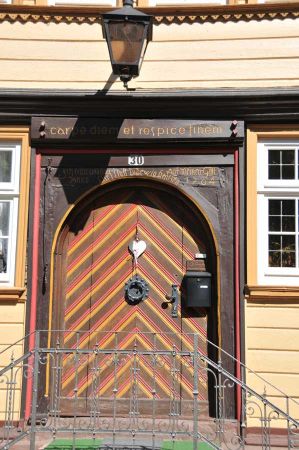 Despite several conversions, the magnificent appearance of the house has been preserved to this day. The house with its extremely steep half-hipped roof, with an incline of 57 °, gives a tower-like impression. The massive ground floor made of quarry and field stones carries three storeys of a half-timbered construction, the special feature of which is a beautiful, polygonal half-timbered bay from the first to the third floor.
Despite several conversions, the magnificent appearance of the house has been preserved to this day. The house with its extremely steep half-hipped roof, with an incline of 57 °, gives a tower-like impression. The massive ground floor made of quarry and field stones carries three storeys of a half-timbered construction, the special feature of which is a beautiful, polygonal half-timbered bay from the first to the third floor.
The coin production was a complicated process and made high demands on all employees. There were specialists for each step, such as a sample stretching and minting master, smelter and adjuster.
In the county of Stolberg, galena was predominantly promoted and smelted on site. The silver obtained was delivered to the coin workshop for special transports. There, the precious metal was first melted and poured into bars. From the melting process to the minting of the coins, all steps can be modelled in the workshop area of the museum. Stolberger coins very often show the coat of arms or the portrait of the ruling counts as well as the deer, the heraldic animal of the counts of Stolberg. The basic principle of minting has not changed from the beginning of coin production until today, but the technical development has.
On the occasion of this once important economic coin minting, the so-called minting of the annual medal takes place in the Museum "Alte Münze" on January 1st of each year. With this mint, Stolberg can proudly refer to the only fully preserved historical coin workshop of the 18th century in Europe associated with it. Another reason to visit Stolberg in winter.
Please also read:
Trip-advice- Visit the European Rosarium in Sangershausen
A walk through the old town of Naumburg
-
 Stolberg - beautiful half-timbered houses
Stolberg - beautiful half-timbered houses
Stolberg - beautiful half-timbered houses
Stolberg - beautiful half-timbered houses
-
 Stolberg - beautiful half-timbered houses
Stolberg - beautiful half-timbered houses
Stolberg - beautiful half-timbered houses
Stolberg - beautiful half-timbered houses
-
 Stolberg - beautiful half-timbered houses
Stolberg - beautiful half-timbered houses
Stolberg - beautiful half-timbered houses
Stolberg - beautiful half-timbered houses
-
 Stolberg - beautiful half-timbered houses
Stolberg - beautiful half-timbered houses
Stolberg - beautiful half-timbered houses
Stolberg - beautiful half-timbered houses
-
 Stolberg - beautiful half-timbered houses
Stolberg - beautiful half-timbered houses
Stolberg - beautiful half-timbered houses
Stolberg - beautiful half-timbered houses
-
 Stolberg - beautiful half-timbered houses
Stolberg - beautiful half-timbered houses
Stolberg - beautiful half-timbered houses
Stolberg - beautiful half-timbered houses
-
 Stolberg - beautiful half-timbered houses
Stolberg - beautiful half-timbered houses
Stolberg - beautiful half-timbered houses
Stolberg - beautiful half-timbered houses
-
 Stolberg - beautiful half-timbered houses
Stolberg - beautiful half-timbered houses
Stolberg - beautiful half-timbered houses
Stolberg - beautiful half-timbered houses
-
 Stolberg - beautiful half-timbered houses
Stolberg - beautiful half-timbered houses
Stolberg - beautiful half-timbered houses
Stolberg - beautiful half-timbered houses
-
 Stolberg - beautiful half-timbered houses
Stolberg - beautiful half-timbered houses
Stolberg - beautiful half-timbered houses
Stolberg - beautiful half-timbered houses
-
 Stolberg - beautiful half-timbered houses
Stolberg - beautiful half-timbered houses
Stolberg - beautiful half-timbered houses
Stolberg - beautiful half-timbered houses
-
 Stolberg - beautiful half-timbered houses
Stolberg - beautiful half-timbered houses
Stolberg - beautiful half-timbered houses
Stolberg - beautiful half-timbered houses
-
 Stolberg - beautiful half-timbered houses
Stolberg - beautiful half-timbered houses
Stolberg - beautiful half-timbered houses
Stolberg - beautiful half-timbered houses
-
 Stolberg - beautiful half-timbered houses
Stolberg - beautiful half-timbered houses
Stolberg - beautiful half-timbered houses
Stolberg - beautiful half-timbered houses
-
 Stolberg - beautiful half-timbered houses
Stolberg - beautiful half-timbered houses
Stolberg - beautiful half-timbered houses
Stolberg - beautiful half-timbered houses
https://www.alaturka.info/en/germany/saxony-anhalt/5090-stolberg-one-of-the-pearls-of-the-southern-harz#sigProIdb79a828e01
